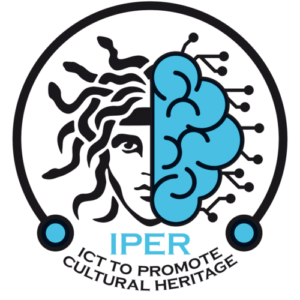Results
Cultural heritage operators will become more:
– able to seize the opportunities offered by ICTs and digital technologies
– open to creativity and entrepreneurship
– able to connect with disabled people and other sectors, such as tourism, gastronomy, SMEs, startups and technology.

To achieve the project goals, the partnership will produce the following outputs:
- Define the State of the Art on promotion of cultural heritage and use of digital tools according to accessible tourism principles needed in the CH sector (Cultural Heritage) drawing on partner research and on the strengths and wide experience of the consortium in research, needs analysis and training;
- Develop the most relevant Case Studies best practices which should be taken into consideration when analyzing the weaknesses and the strengths of cultural heritage promotion;
- Design a nano-learning and needs-oriented training course which integrate several sector-specific and transversal skills, including digital, entrepreneurial, and soft skills. It will be supported by a set of OER that, together with the case studies, will represent the main contents of the training system.
MONITOR AND EVALUATION
A Monitoring and Evaluation Committee (MEC) will monitor the project throughout its phases. The MEC will hold periodical meetings, mainly during the project transnational meetings but also by phone or videoconference if needed.
Download our Monitoring Reports:
PROJECT MANAGEMENT AND IMPLEMENTATION
The activities related to this WP aim at achieving the following objectives:
- Administrative and financial management regarding budgeting and administration documents;
- Project coordination including organization, communication and leadership of the working group;
- Preparation and sharing of administrative and operational guidelines and development of systems for electronic sharing of data and information (a cloud based project managing platform freedcamp.com).
- Administrative and financial management include the control of the financial flows, the budget and the communications with the funding body.
The main aim of this phase is coordinating and managing the whole project organization for its entire duration, from an administrative point of view, organizing the procedures and relations with the funding body and the budget management and from a working point of view, making the partnership cooperation productive and effective. All partners have been involved sharing the work plan according to the activities, roles and responsibilities.
CCIS, supported by the project partners, leads this phase.
The main activities related to this WP are:
- Implementation of the managing guidelines
- Reporting procedure for both the activities carried out by each partner and expenditures and definition of the administrative guidelines
- Financial Reporting.
Download our support material:
– Template Consortium Agreement
Meeting Templates:
– Certificate of attendance
SELF-EVALUATION
All the intellectual outputs will be evaluated by the MEC in order to guarantee their overall quality. Since the evaluation involves all the project partners its process will be continuous and it will allow a constant monitoring and improvement of the intellectual outputs. The evaluation methodology (questionnaires, focus groups, and other qualitative and quantitative evaluation techniques) and the frequency of the quality checks will be defined according to the characteristics of each intellectual output. An evaluation report for each Output will be produced.
EXTERNAL EVALUATION
The beta version of the training materials will be evaluated by a representative sample of direct beneficiaries during the pilot tests. According to the results of this evaluation the beta version of the training materials will be, if necessary, modified, adapted and improved in order to obtain the final version of the training system.
The main aims to reach through the development of the WP6 are:
– The dissemination and the promotion of the project activities, to spread the project and its products to the largest number of final users, potential interested people and to involve key-actors in the reference context, stakeholders and policy makers;
– The dissemination and use of the results, at long and short term, to guarantee further developments of sustainability and transferability of the IPER actions to other local sectors and contexts.

To achieve these objectives the following tools will be used:
– Project graphic design: project logo, project website graphic structure, project slide show layout, brochure and newsletter Layout.
– Project website: available in all the project partners’ languages (ES, HU, PT, IT) and in English;
– Project profile pages on social networks (such as Twitter and Facebook); paid Facebook campaigns will be foreseen during main events and meetings.
– Mailing list of organisations, institutions and experts interested in project topics: each partner will provide a mailing list (at local, national and European level), constantly update the mailing list, and use the mailing list to disseminate information, news and project’s products.
– Newsletters: they will be structured in thematic editions. The main aim of the newsletters will be updating the target groups and the sector main stakeholders on the actual situation of the project, the implementation of project products and deliverables and, in general, on the main fields of the project.
– Advertisements on informative channels: each partner will promote and disseminate the project and its results on the information channels at local and international level, through advertisements on newspapers, news publication on Internet.
– Project leaflet: the leaflet will include a general presentation of the project; it will be developed firstly in English (by UDS) and then translated in all the partnership languages. It will answer to two main goals: dissemination at local-national level (national language) and dissemination at transnational level (English).
– Dissemination gadgets to be disseminated during events.
– Final dissemination conference held in Spain and 3 national dissemination conferences.
Communication Kit:
– Evaluation of project activities
– Deliverable description template
Download our support material:
%
the current state of cultural heritage promotion and use of digital tools.
%
of the current proposal for accessible tourism regarding places and structures related to cultural heritage.
%
and analysis of data relating to the state of the art.
%
the minimum criteria and parameters of best practices that will emerge from the case studies.
%
a group of beneficiaries who will be involved in the experimentation and testing of the training materials.
%
of nano learning training modules.
%
and monitoring.
%
of project results.
